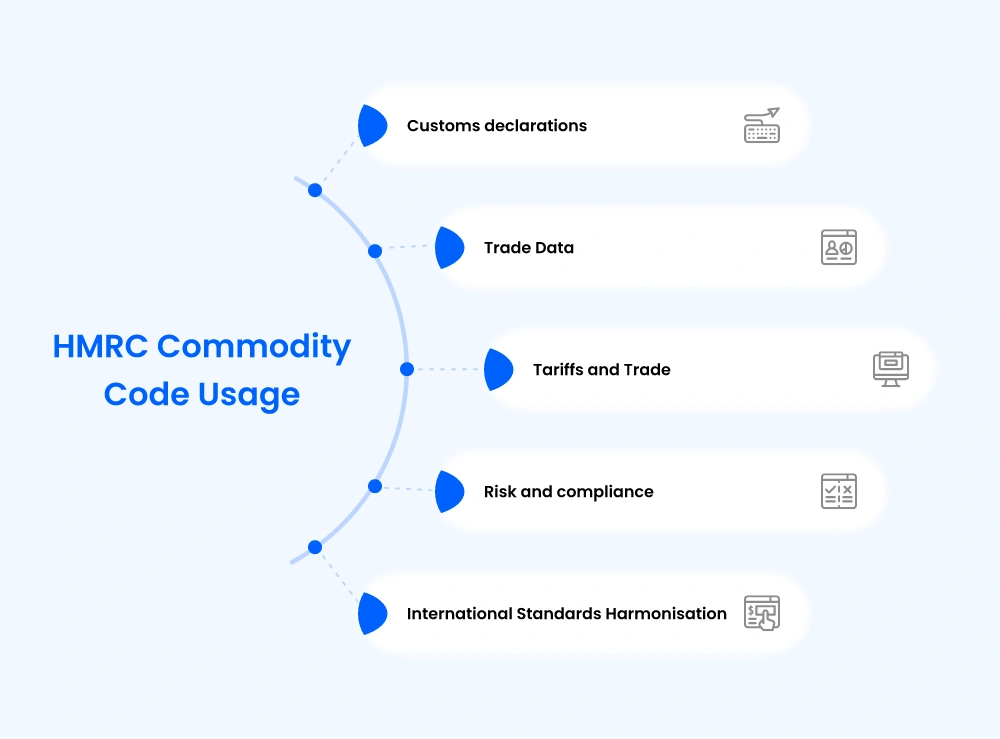Fast & Accurate ENS GB & EU ICS2 Solutions Built for You.
Understanding the Importance of Commodity Code Classification
- Freya Jane
- Director of Customer's Success
According to UNCTAD, $32 trillion worth of goods were exchanged globally in 2022, making the world of international trade a thriving marketplace. Importers and exporters find international trade complicated. Understanding and using commodity codes, often called Harmonised System (HS) codes, are essential to international commerce. These numbers make it easier to identify and categorise different types of items.
In this extensive guide, we will discuss the significance of commodity codes and their structure, as well as how to estimate them and make optimal use of them accurately.
What is a commodity code?
Harmonised System (HS) codes describe commodities sold worldwide. The WCO’s Harmonised System includes them. Customs officials and merchants worldwide use commodity codes to communicate.
Commodity codes are a string of numbers that give extra product details. Hierarchically, the first six numbers are the worldwide HS code. Each number gives more particular information, enabling exact product classification. The literal definition of commodity codes states that;
A series of well-defined numbers usually contains ten digits to determine the codes of the goods imported or exported worldwide. These coding methods are called commodity codes and are used worldwide.
Commodity codes aid in customs clearance and trade data collection. These codes define customs charges, levies, and rules for certain commodities. Importers and exporters use commodity codes to comply with trade restrictions, permit correct customs assessments, and provide trustworthy trade data.
Here’s an example of a commodity code:
HS code for apples: 080810
This code indicates that the product is:
Section 08: Edible fruits and nuts; citrus fruits and melons; dried dates; chestnuts and marrons; other edible dry nuts
Chapter 08: Edible fruits and nuts, dried dates, chestnuts and marrons, other edible dry nuts
Heading 0808: Apples, pears and quinces, fresh or dried
Subheading 080810: Apples, fresh
Learn more about HS codes for importers & exporters. Click here!
Key considerations for determining commodity codes
According to the UK Govt. when choosing the right commodity code tariff for your goods in international trade, take into account a number of criteria:
- Product type: Indicate the kind and classification of the item.
- Intended use: Describe the main objective or feature of the product.
- Materials employed in production: List the primary materials used in the production process.
- Details of the manufacturing process: Describe the manufacturing or assembly process used to create the product.
- Packaging methodology: Give a description of the product’s shipping packaging.
Country-specific commodity code challenges
National classification and variation: Some countries have their own classification system, making it difficult to classify some goods due to variation across different nations.
Tariff and duty differences: Duty and tariff vary greatly among countries, even for the goods having the same HS codes. Certain goods may be eligible for reduced or zero tariffs under preferential trade agreements, but it can be difficult to understand these agreements and their particular regulations.
The complexity of trade agreements: It can be difficult to comprehend the complicated rules of origin that establish whether a product is eligible for preferential treatment under a trade agreement. These regulations frequently include specifications pertaining to value added, manufacturing procedures, and material origin.
Compliance and licensing: Some nations have specific compliance and licensing requirements, including certifications and permits. The requirements keep changing with time, making it difficult for businesses to stay compliant.
Why is the HMRC commodity code used?
The commodity code HMRC is a national platform that provides the codes, including the VAT percentage, for almost every product. The tariff is the name of the platform that provides the codes. Hence, it offers several benefits that make it useful, such as:
Customs declarations
HMRC commodity codes govern customs declaration categorisation. Customs paperwork must include the correct commodity code for imports and exports. The code helps customs officials determine customs duties, taxes, and rules for traded commodities.
Trade data
UK trade figures depend on HMRC commodity codes. The codes standardise import and export data collection. Monitoring trade flows, market trends, and trade policy needs this data.
Tariffs and trade
Tariffs and trade policies employ the UK commodity codes. These codes classify items to calculate tariffs, duty exemptions, and preferential trade agreements. HMRC enforces trade restrictions and trade agreements using import commodity codes.
Risk and compliance
HMRC evaluates import/export risk using HS commodity codes. Some goods are regulated, licenced, or banned. HMRC may focus on inspections, identify high-risk shipments, and enforce trade compliance by precisely identifying products.
International standards harmonisation
HS codes match HMRC commodity codes. The HS standardises product categorisation worldwide. HMRC harmonises and standardises international trade practices using HS-based commodity codes, making trade and data sharing easier.
Overall, customs declarations, trade data, tariff administration, risk assessment, and compliance employ HMRC commodity codes. They offer a standardised categorisation system for accurate customs duty assessment, trade policy execution, and UK trade statistics.
Why are commodity codes necessary?
There are various reasons why the commodity codes are essential, like the fact that they standardise international commerce.
Simplifying the product description
Commodity codes identify and categorise a wide range of items traded internationally. This categorisation standardises customs processes, paperwork, and trade data globally.
Defining accurate tax amounts
Customs commodity codes determine duties, taxes, and fees. Customs officials can precisely evaluate taxes and duties by coding goods. This promotes fair commerce and government income by ensuring importers and exporters follow customs procedures and pay suitable tariffs and taxes.
Trade data analysis
Customs commodity codes also aid trade data analysis. These codes provide complete and accurate information on international trade flows to governments and organisations.
Commodity code data allows the examination of trade patterns, market trends, and industry or product economic effects. This data aids policymaking, strategic planning, and trade opportunity identification.
Improving risk management
Customs commodities codes improve trade compliance and risk management. Import, export, licensing, and health and safety standards may apply to certain items.
Customs officials can detect and handle product hazards by appropriately categorising commodities with the correct commodity code. This improves border security, regulatory compliance, and public safety.
Promoting transparency
Custom commodity codes harmonise commerce and improve discussions. Globally, commodity codes are based on the Harmonised System (HS). Classifying and organising products simplifies trade processes, promotes transparency, and facilitates trade talks and agreements between nations.
How do inaccurate commodity codes impact businesses?
Businesses engaged in international trade may suffer serious repercussions from incorrect commodity code classification. Here are a few noteworthy examples:
- Financial penalties: Businesses that misclassify goods risk paying large fines, which could have an effect on their profitability.
- Operational disruptions: Inaccurate classification can lead to customs clearance delays, disrupting supply chains, which can result in missed deadlines and possibly lost sales.
- Reputational damage: False classifications damage customs officials’ credibility, which affects shipments in the future and impedes company expansion.
Finding a commodity code for a product
There are numerous ways through which the commodity code of a product is obtained, but the HMRC tariff system is the ultimate one. Now, the part of the question that asks about how to get a code is very simple. Search for the keyword of the product type on the Tariff UK website and match your product with the specifications provided there. That’s how you can acquire the most appropriate and suitable code for it.
These commodity codes UK have accurate results for the utmost of 8 digits. Usually, the six digits are the same worldwide, and the rest of the four digits are country-specific. On the contrary, the companies that provide customs declaration services to the customer also offer commodity code checkers and commodity code lookups.
Another question that appears is how to check a commodity code. If you are using the CDS software, you can always re-check the commodity codes of the goods through HMRC. But now, HS-code lookup is a feature that gives the advantage of obtaining commodity codes directly. As soon as the file containing the product information is uploaded, the smart AI software obtains the codes.
Eliminate the risk of error and improve efficiency with our AI-driven iClassification tool! Start Now!
Commodity Code Checker

UK Integrated Online Tariff
Best match Products Name or products description , you can select any of them to check and calculate duty rate, VAT rate and total landed cost.
- Searching...
This tariff information is for the UK only
iCustoms Commodity Code features
As we mentioned earlier, many firms provide CDS facilities. Here, we are mentioning iCustoms and whether its commodity lookup is reliable. iCustoms ensures that the codes provided are 100 % accurate and efficient. It gives commodity code features like HS commodity classification, HS code lookup, and HS code classification.
That effectively aligns with giving the best results using its highly anticipated AI technology. Not only this, but it also provides a complete AI advanced package for stress-free customs declaration. Take a moment to learn about iCustoms services and plan to streamline your customs operations.

Conclusion:
It would only be possible to conduct international commerce with commodity codes. Importers and exporters may successfully use trade agreements, collect reliable trade data, and streamline customs procedures using relevant codes. Finding the correct commodity code for your product requires understanding its structure.
Furthermore, the importance of commodity codes must be considered. Through in-depth research and leveraging available resources, businesses can optimise their global commerce operations. By following best practices and staying up-to-date with relevant legislation, enterprises can minimise the risks associated with incorrect categorisation.
For instance, iCustoms is an advanced solution for finding the accurate commodity code concerning a product. Its built-in AI features enable it to handle the bulk of data in seconds. Take a moment to learn about the iClassification service that provides Hs code lookup and Hs mapping tools for accurate results.

Discover the power of iCustoms’ iClassification tool and simplify your trading journey.
FAQs
What are commodity codes and HS codes?
For customs clearance, trade statistics, and regulatory compliance, a commodity code, sometimes called a tariff code or classification code, categorises items or products numerically. HS stands for Harmonised System Code. The WCO's Harmonised System classifies items worldwide.
What is an 8-digit commodity code?
An 8-digit commodity code extends the 6-digit Harmonised System (HS) code to classify commodities more precisely.
Is the HS-lookup tool in iCustoms easy to use?
Indeed, iCustoms software is user-friendly, reliable, AI-based and easy to operate. Furthermore, its HS lookup tool correctly identifies the commodity code when the goods files are uploaded.
What is the 11-digit commodity code?
The 11-digit commodities code is a specialised code used in international trade to describe and categorise items for customs clearance.
You may also like
Streamline Product Classification
Uncover iClassification for precise Global Trade, Delivering Time-Saving Accuracy.
Subscribe to our Newsletter
About iCustoms
Streamline Product Classification
Uncover iClassification for precise Global Trade, Delivering Time-Saving Accuracy.



